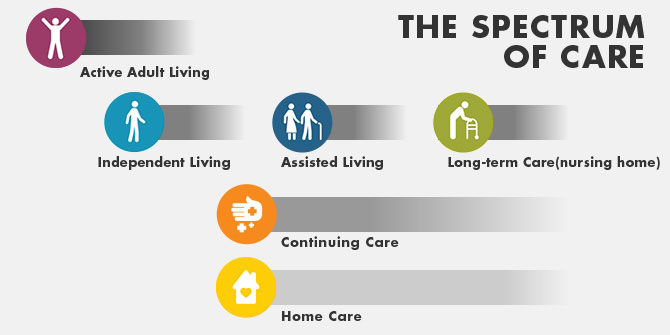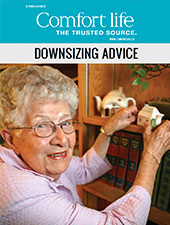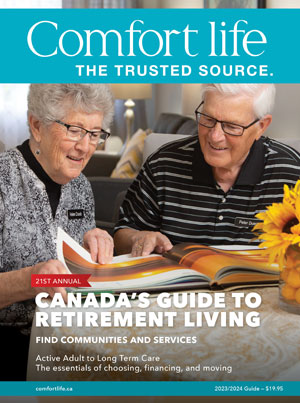Lists of reports on this page:
Find care details, insights, and insider perspectives gained from 20+ years of helping seniors and families.
What to know about this topic:
- Types of retirement care in North York
- How much does a retirement home in North York cost?
- Medical and safety services
- Recreation and social activities for seniors
- Getting around North York
- Availability of retirement homes in North York
- Choosing a retirement community
- Retirement community regulations in North York
North York, a diverse community within the city of Toronto, is sometimes known as the city’s “second downtown.” A fusion of peaceful suburban landscape and urban living interspersed with parkland, North York is home to a number of excellent retirement homes, from single-floor to high-rise. This is your guide to finding the right retirement community in the evolving cultural hub that is North York.
IN-DEPTH REPORTSRetirement communities in North York
Sagecare 147 Elder Street
Enlightened dementia care touches more than memory. 147 Elder St. is a place that provides opportunities for the joy and meaning still ahead when wellbeing can no longer be realized at home.
Lifestyle Options: Memory Care
Greenview Seniors Residence - Metta Lifestyles
At Greenview Residence, we offer a complete range of care services in a welcoming environment. Whether it's our compassionate staff, fresh homemade meals, or exciting and engaging activities, you will truly feel at home.
Lifestyle Options: Assisted Living, Memory Care
Don Mills Retirement Residence - Verve Senior Living
A luxury senior living community in the heart of North York. Be inspired by beautifully appointed amenities in our state-of-the-art building offering exceptional care, intelligent technology & exciting life enrichment.
Lifestyle Options: Independent Living, Assisted Living, Memory Care
Delmanor Northtown
Delmanor Northtown is a full-service boutique retirement residence located in the heart of North York, catering to active and independent seniors.
Lifestyle Options: Independent Living
Canterbury Place Retirement Residence - Verve Senior Living
Canterbury Place offers a variety of suites styles in an elegant condo-like building for active adults & those needing assistance. We offer a unique healthcare program for our residents including palliative care.
Lifestyle Options: Independent Living, Assisted Living
Forestview Retirement Residence
Forestview Retirement Residence is North York's newest seniors' residence. We offer Independent Lifestyle and Full Service Assisted Living Accommodations and Services, plus Short Term and Respite Stays.
Lifestyle Options: Independent Living, Assisted Living
Delmanor Wynford
A full service 5-star retirement community centrally located in Toronto - features extensive common areas, a rooftop putting green and a variety of other amenities catering to today's active seniors.
Lifestyle Options: Independent Living
Types of retirement care in North York
Retirement homes in North York serve mainly seniors and families from the immediate community, and can be found in both residential and urban market areas. Whether your preferred location is in a suburban area or right on Yonge Street, you can find the full spectrum of care (see image below) in both landscapes in this part of Toronto.

Independent living
Active retirees generally choose independent living, the option which caters to seniors who enjoy the safety, community and amenities of retirement living, but who want to remain independent. Some communities equip apartments or town homes with kitchens and individual gardens, others offer meal plans and light housekeeping.
Assisted living
Seniors in assisted living residences can customize their care to suit their health care and comfort needs. Assisted living, sometimes called supportive living, bridges the gap between independent living and long-term care, offering personal care, medication management, full meal preparation and housekeeping to seniors that are beginning to find everyday tasks cumbersome. Most retirement communities, even independent living residences, embrace the idea of aging in place and offer assisted living services to their residents.
Long term care
Long-term care provides comprehensive care to seniors with greater health demands who require more personal attention and specialized treatment than is available in assisted living. Memory care suites and services, such as special therapies, are also available in long term care to those seniors suffering from Alzheimer’s or advanced stages of Dementia.
How much does a retirement home in North York cost?
Although North York does not have the highest average retirement costs in the GTA, less than 15 percent of its standard suites have a monthly cost below $3,000. Almost 70 percent of vacant suites in the region have monthly costs above the provincial average of $3,200 and most of the area’s homes cost between $3,500 and $5,000 a month. Paying for a retirement home may seem like an expensive endeavour, but keep in mind that the cost of a retirement home includes the costs of rent, home maintenance, health care, meals, housekeeping and recreational activities in one monthly fee. Every retirement community will include different services in their monthly packages and some may charge for additional services depending on the type of retirement living you choose. For example, an independent living community may include cable, recreation and housekeeping, but charge a fee for personal care. Well-managed retirement homes are open about the varying costs of different suites and care options in order to help you or your loved one(s) plan for the future.
Some of the most common ways of paying for retirement are through savings, pensions, Canadian Pension Plan (CPP) and Old Age Pension. The sale of the family home is also a good way to finance retirement costs.
Long-term care homes, which are funded by the government of Ontario, have their rates for basic accommodation set by the province. Your local Community Care Access Centre can help you and your loved one(s) find placement in a long-term care home near you, and provide more detailed cost information. Some residents of long-term care homes living in basic accommodations and who have an annual income below $21, 000 may be eligible for a rate reduction. Although long-term care is subsidized by the government, very few independent and assisted living homes offer subsidized housing. However, seniors can apply for rent geared-to income units in Toronto, which charge 30% of a tenants income as rent. According to the East York Housing Help Centre “The largest organization of subsidized housing is the Toronto Community Housing Corporation… There is a long waiting list for RGI housing in Toronto. RGI units are located in many different types of non-profit housing.” To find out more about subsidized housing in Toronto, visit the East York Housing Help Centre website. The Ontario government can also be helpful when it comes to additional expenses, such as home care or prescription expenses. Seniors with high prescription drug costs relative to their income may benefit from applying to the Trillium Drug Program. Seniors over the age of 65 who live in Ontario and have a valid Ontario health card are eligible for application.
Medical and safety services
There are many resources Toronto seniors can turn to for health care. The city is home to more than 30 hospitals, and many more specialized care centres, such as chiropractic, dental, and foot care clinics. For seniors residing in retirement living, the closest resource is most often right at home. Modern retirement homes offer a range of medical services and make resident health and safety their first priority. Long-term care offers the most extensive medical care, whereas independent living and assisted living shift the focus more onto preventative care, social and emotional wellness and active living. With age, reduced mobility, sight and hearing can make everyday activities more dangerous and increase the risk of falls.
In order to prevent injuries and accidents, safety is a large part of the design of retirement homes. Fire-proofing, well-trained staff, and sensitive alarms all increase fire safety, and three-piece showers, non-slip floors and night lighting can be found in many suites. One safety feature virtually all retirement communities share is an emergency call system, which alerts staff to an emergency at any time of the day or night. Today’s understanding of health is not just limited to preventing injuries, however.
Well-run retirement homes know that nutrition, fitness and mental and emotional health are all part of wellness. Every residence or association will have a slightly different approach to ensuring wellness. One group of residences in North York assigns a coach to each resident as they move in, who goes over their goals with them initially and then continues offer support in every area of health – mental, physical and social – at weekly meetings. Although not every residence has a mentorship program such as that mentioned above, retirement homes can many services in the interest of providing holistic health care, including:
- Regular check-ups and visits from an on-site or visiting doctor
- On-site nursing staff, often available 24/7
- A pharmacy
- Fitness classes with personal trainers or fitness co-ordinators
- Physiotherapy
- Foot care, manicures and pedicures
- Massage therapy
- Chiropractic care
- Dietary advisement
- Dental health care
- Hair dressing
- Memory care and family support
- Specialized therapy (music, drama, memory therapies)
Although retirement homes no longer need to outsource most of their health care, some residences, especially independent living communities, co-ordinate with third party health-care providers, including dieticians and gerontologists, as well as larger organizations such as the Local Health Integration Network and the Alzheimer’s Society of Toronto. The Alzheimer’s Society and the LHIN, as well as the North York and East York senior’s centres and a number of private home health care organizations can all provide assistance to seniors living at home or in retirement care and their families. The Alzheimer’s Society offers counselling, support and education to both those with Alzheimer’s and their loved ones. See the section below for more information on the region’s senior centre services. In case of an emergency or a need for surgery or specialized care, the city of Toronto has a large number of hospitals that provide primary, acute, critical and surgical care. Although the highest concentration of hospitals is downtown, the North York General hospital, Humber River Hospital and the East York Hospital are closest to most areas in the community of North York.
Recreation and social activities for seniors
A wide social network of seniors, opportunities for ongoing learning, creative outlets and a variety of fitness programs are some of the benefits of retirement living. Staying social and keeping busy both physically and mentally are important pillars of senior health, and North York’s seniors centres and retirement communities strive to give the 65+ community as many opportunities to do so as possible. One myth surrounding retirement living is that moving into a retirement residence means seniors give up vibrant, creative lives for a more mundane lifestyle. While you or your loved(s) one may not be able to take all of your belongings with you when you move, retired residents are encouraged to continue doing what they love and can bring their personality to their suite.
Retirement can certainly be peaceful, but there is more than enough room for active seniors to exercise their passions, be they creative, athletic, or otherwise, and of course, plenty of opportunities to learn something new. Some of the many recreational and wellness activities offered in retirement living include:
- Fitness and gentle exercise classes
- Yoga and zumba
- Aquafit and swimming
- Billiards
- Line dancing
- Residence parties
- Shuffleboard
- Painting and art classes
- Concerts
- Theatre performances
- Golf and minigolf
- Movie nights
- Card games and tournaments
- Volunteer opportunities
There are a number of seniors centres in and around North York, which are open to both seniors living at home and in retirement communities. In fact, many retirement homes partner with local seniors centres and community organizations to give residents access to more programs, facilities and services. The North York Seniors Centre (NYSC) serves to connect seniors through day programs and active living, and also offers transportation services (see section below ) and in home services. According to the NYSC’s website, the A Day Away club “provides older adults with physical frailties or cognitive challenges an opportunity to… have fun in a safe and caring environment.” Active adults can become members of the Active Living Centre (conveniently located on the Yonge subway line) in order to take advantage of events, classes, trips and special services such as arts and culture programs and multicultural social groups. Located further south-east near the shops at Don Mills, the Better Living Centre offers similar services including free exercise classes, special seminars, and trips to festivals and attractions throughout Ontario. The Thornhill Community Centre in Markham is just north of North York and is home to the Thornhill Seniors’ Club. The club offers activities such as card tournaments, bingo, Seniors’ Day celebrations, and a variety of classes, from dance to Spanish lessons. Teens and adults of all ages can also find volunteering opportunities at any of the area’s seniors’ centres.
Toronto is not known for its rural landscapes, beaches or hiking trails, but North York’s urban areas are interspersed with parkland, tennis courts and golf courses. Retirement homes with no more than several floors are often situated in residential areas, and have large properties with pathways and fitness activities, but even those in more urban settings can offer their residents walking paths and putting greens – with a view. Several of North York’s retirement homes have converted their roof-space into green space, complete with trees, lawns and gardens.
The appeal of living in a big city is the diversity and access to modern amenities. Seniors in North York can take advantage of the diverse dining and shopping options along Yonge street and in nearby downtown Toronto. Retirement homes generally co-ordinate outings for their residents, and the theatre, art galleries, sports event and festivals in Toronto are countless. Excursions to the ROM, the AGO and to concerts are popular, as well as trips around Ontario – to Niagara falls or the Christmas market in Kitchener- Waterloo. Closer to home is Mel Lastman square, North York’s centre for festivals, arts and culture. The square is comprised of 20, 000 square feet of open space, a reflecting pool, a garden and an amphitheatre. Quieter than downtown Toronto, the city’s “second downtown” boasts a central library, two movie theatres, a centre for the arts and many of its own cultural festivals in Mel Lastman square which seniors can enjoy not only on planned outings but also with visiting family and friends.
Getting around North York
Although North York boasts an expanse of parkland and trails, Toronto is far from becoming a fully bicycle and pedestrian friendly city. Active seniors can get around by bike or on foot, but also have access to one of the most extensive transit networks in Ontario – the Toronto Transit Commission (TTC) together with GO transit. Seniors can use buses, as well as the Sheppard and Yonge subway lines and the Barrie and Richmond Hill GO train lines to travel around the city and connect themselves to the entire GTA and travel as far as Hamilton, Oshawa, Waterloo and Lake Simcoe. The TTC offers discounted fares to patrons 65 years and older, and all buses and subway trains are accessible. GO transit fares are also reduced for seniors. The easiest way for older adults who travel frequently to manage fares is through the PRESTO card program, which allows them to take advantage of all seniors discounts and transfer between cities.
Mobility-challenged seniors can apply for Wheel-trans, the TTC’s accessible-door to accessible-door transportation service. Applicants must attend an interview to determine eligibility for this service. Retirement homes most often have their own accessible buses that are used primarily for planned outings and day-trips, as well as weekly shopping trips, bank runs, and other errands. Some communities also provide their residents with transportation to medical appointments aboard these buses, but generally, residents rely on family and friends, community services, or themselves, for transportation. North York seniors can also get around by applying for transportation services with the North York seniors centre. The centre operates a fleet of four mini-vans which can take seniors to their medical appointments, on shopping trips and to and from seniors centre activities from Monday through Friday between 8:30 am and 4:30 pm. Seniors who drive can take advantage of the convenient access to many major routes and highways in North York, such as the 401 and the DVP. Reserved parking is available in retirement living for driving residents.
Availability of retirement homes in North York
Ontario’s retirement homes are well regulated, safe and welcoming – unfortunately this also renders vacancy rates relatively low. In the interest of becoming a WHO age-friendly city, the city of Toronto has pledged to add more geared-to-income units to the landscape over the coming years. According to the 2014 seniors housing report, the addition of new units makes North and East York the areas with the highest vacancy rates in the GTA, at 22.4 and 33.4 percent. However, the provincial vacancy rate remains in the range of 13.9 percent. As a result, you or your loved one may have to spend time on a wait-list before moving in to the retirement home of your choice. Certain factors will inform the length of wait times:
- Crisis placement (if someone’s safety poses immediate risk)
- Type of accommodation: basic, semi-private or private or secure floor (Private or semi-private are more expensive but have shorter wait-times)
- Gender
- Medical care needs i.e. tube-feeding
- Unit designation- secure, non- secure
Choosing a retirement community
Choosing a retirement home is a big decision that requires thought and pre-planning. Unfortunately, many seniors and their families don’t think about retirement living until a time of crisis. This can cause unnecessary stress and make your search more difficult. Whether you have been excited about retirement living for a while or are opting to live at home for the time being it is important to consider all your options.
The search for a retirement home doesn’t have to be stressful. Before you begin your search, ask yourself and your loved ones the following questions.
- What you want
- What you need
- What you can afford
- Your preferred location
You can visit our page for seniors considering a retirement home for a more comprehensive list of questions to consider in advance. If you are unsure what kind of care you will be able to afford, use our retirement calculator. The next step is creating a short list of retirement residences and begin visiting the communities that meet your needs. Remember to ask questions when touring retirement homes. For a full checklist to ask about, download our free e-book on the ultimate retirement tour guide. Start your search today by contacting the North York residences shown above, or use our advanced search to narrow down your options.
Retirement community regulations in North York
Ontario’s retirement homes are regulated by the Retirement Homes Regulatory Authority (RHRA), which inspects retirement homes, oversees compliance and enforces the Retirement Homes Act to protect residents. The RHRA has a Public Register available on their website which lists retirement homes that have applied for a license or are already licensees. Always remember to check a retirement residence’s RHRA status before making your decision. Industry experts also recommend looking for an accredited retirement community that is a member of a trusted authority.
Membership in other organizations is a further sign that a retirement community will be safe and well-managed. Many Toronto retirement homes are members of provincial and national associations, including:
- The Ontario Retirement Communities Association (ORCA)
- The Ontario Long-term Care Association (OLTCA)
- AdvantAge Ontario (formerly the Ontario Association of Non-Profit Homes and Services for Seniors: OANHSS)
- The Canadian Association of Retired People (CARP)
In addition to the regulations set by the RHRA, all long-term care homes in Ontario are governed by the Long-Term Care Homes Act 2007. The act requires residences to provide safe, consistent and high-quality resident-centred care and makes sure residents feel at home, are treated with dignity and respect, and have the health care services they need available to them.





